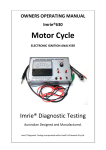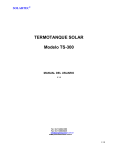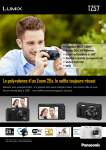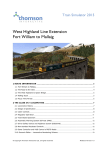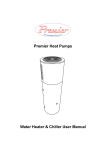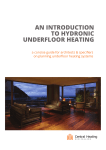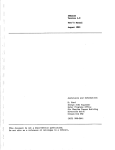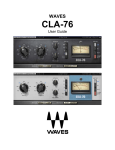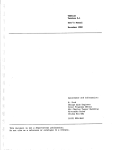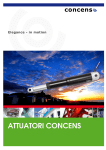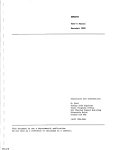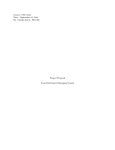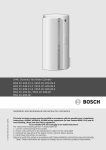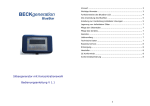Download Installation and Instruction manual TZ Series_Bluey
Transcript
Installation and Instruction Manual For: BLUEY Solar Water Heater System Version 1.2 Issued data: Aug 21, 2014 This manual applies to model: TZ250E-25R-250L,TZ250E-30R-250L,TZ315E-25R-315L,TZ315E-30R-315L, TZ315E-40R-315L,TZ400E-30R-400L,TZ400E-40R-400L. The appliance must be installed, commissioned and serviced by an authorised person in accordance with: 1 1. AS/NZS 3500.4 - National Plumbing and Drainage. Part 4: Heated water services 2. AS/NZS 3000 – Electrical installation 3. Local plumbing regulations www.bluesun-group.com.au Blue Sun Group Pty Ltd 2 www.bluesun-group.com.au content Importance information and warning ..........................................................................................4 1. System specifications .............................................................................................................6 2. Importance components of the system...................................................................................9 2.1 Solar collectors ..............................................................................................................9 2.2 Hot water storage tank ................................................................................................21 2.3 Pump Station(Include pump and controller) ................................................................22 2.4 Electric element and thermostat ..................................................................................23 2.5 Water pipes .................................................................................................................24 3.System installation procedure ...............................................................................................25 4. Operating and Maintenance .................................................................................................27 4.1 Operating .....................................................................................................................27 4.2 Maintenance requirements ..........................................................................................27 5. Safety devices ......................................................................................................................29 5.1 Pressure & Temperature Relief (PTR) Valve ...............................................................29 5.2 Expansion Control Valve (ECV) ..................................................................................30 6. Trouble shooting ...................................................................................................................31 7. System tracking ....................................................................................................................33 APPENDICES : User Manual of PUMP STATION ...................................................................33 3 www.bluesun-group.com.au Importance information and warning Before installing and using the water heater, please carefully read the manual and be sure to keep the manual well for reference in the future. 1. This appliance must be installed, commissioned and serviced by an authorized person in accordance with the requirements of AS/NZS 3500.4 or in New Zealand, NZBC G12. 2. This appliance must be installed by a person licensed with the Plumbing Industry Commission. Only a licensed person will have insurance protecting their workmanship. So make sure you use a licensed person to install this appliance and ask for your Compliance Certificate. 3. This appliance is not intended for use by persons (including children) with reduced physical, sensory or mental capabilities, or lack of experience and knowledge, unless they have been given supervision or instruction concerning use of the appliance by a person responsible for their safety. 4. Any power leads from the water heater system components MUST BE plugged into an external weatherproof electrical outlet. If the power supply cord of any water heating components is damaged, it MUST BE replaced by an authorized person in order to avoid a hazard, using genuine replacement parts available from Blue Sun Group Pty Ltd. Take care not to touch the power plugs with wet hands. 5. Care should be taken not to touch the pipe work as it may be HOT! The pipes between the solar collectors and storage cylinder MUST BE copper or alternative material pipes that may be supplied by Blue Sun Group Pty Ltd. Plastic pipe is NOT suited to the water temperatures and pressures that may occur in the system. 6. Hot water can cause scalds, children, disabled, elderly and the infirm are at the highest risk of being scalded. Feel water temperature before bathing or showering. Scalds from hot water taps can result in severe injuries to young children. Scalds occur when children are exposed directly to hot water when they are placed into a bath which is too hot. 7. BLUEY solar water heaters are equipped with temperature relief valve or pressure relief valve. For safe use, do not personally change the installation location. No blocking their exports, diversion pipe must be installed on the temperature relief valve and pressure relief valve and going continuously downwards, and diversion pipe should be connected directly to the floor drain, diversion pipe must not have knots or clogging. 8. The storage tank is fitted with an anode, if the hot water system is not used for two weeks or more, a quantity of highly flammable hydrogen gas may accumulate in the water heater. To dissipate this gas safely, it is recommended that a hot tap be turned on for several minutes or until discharge of gas ceases. Use a sink, basin, or bath outlet, but not a dishwasher, clothes washer, or other appliance. During this procedure, there must be no smoking, open flame, or any electrical appliance operating nearby. If hydrogen is discharged through the tap, it will probably make an unusual sound as with air escaping. 9. The system is designed for the level 1 of frost protection. This type of system is not recommended for hard frosts area because of the risk of the water in the collector freezing 4 www.bluesun-group.com.au and causing damage to the collector. 10. The water quality of most public supplies is suitable for the water heating system. The water quality from bore wells is generally unsuitable for the water heating system. 11. If the user installing the product on their own, solar water heater can-not normally operate or ineffective, even causing the collector or storage tanks falling and other consequences or losses, the company accepts no liability. 12. The installation should not compromise the structural integrity of the building when installing the solar water heater. Interpretation of these provisions belongs to Blue Sun Group Pty. Ltd. If you do not fully act with this manual, it may cause fire, property damage, personal injury or death. 5 www.bluesun-group.com.au 1. System specifications BLUEY solar hot water system is commonly referred to as a split system, it consists of five components. These five components are collector, storage tank, pump, controller and boost element. A Split System is a system where the heated water in the solar collector is moved around by using a small circulation pump and pump controller. The pump draws water from the cold water connection to the tank and circulates the water through the collector, then returns the water back to the storage tank which has been heated free from the sun. Specifications and principal dimensions for the various systems and components are shown in table 1.1 and table 1.2. Table 1.1 System Specifications System Type TZ250E-25R TZ250E-30R TZ315E-25R TZ315E-30R Tank delivery capacity 250 L 250 L 315 L 315L Solar flow and return 3/4” 3/4” 3/4” 3/4” PTR Valve 3/4” 3/4” 3/4” 3/4” Cold Inlet 3/4” 3/4” 3/4” 3/4” Hot outlet 3/4” 3/4” 3/4” 3/4” 850 850 850 850 10 10 10 10 3.6 3.6 3.6 3.6 1 1 1 1 25 30 25 30 Collector inlet 3/4” 3/4” 3/4” 3/4” Collector outlet 3/4” 3/4” 3/4” 3/4” 1 1 1 1 PTR Valve setting (kPa) Rating of PTR Valve supplied (kW) Power consumption of electric heating device(kW) Number of collector Tube quantity of each collector Circulation pump setting 6 www.bluesun-group.com.au 7 www.bluesun-group.com.au Table 1.2 System Specifications System Type TZ315E-40R TZ400E-30R TZ400E-40R Tank delivery capacity 315 L 400 L 400 L Solar flow and return 3/4” 3/4” 3/4” PTR Valve 3/4” 3/4” 3/4” Cold Inlet 3/4” 3/4” 3/4” Hot outlet 3/4” 3/4” 3/4” PTR Valve setting (kPa) 850 850 850 10 10 10 3.6 3.6 3.6 2 1 2 20 30 20 Collector inlet 3/4” 3/4” 3/4” Collector outlet 3/4” 3/4” 3/4” 1 1 1 Rating of PTR Valve supplied (kW) Power consumption of electric heating device(kW) Number of collector Tube quantity of each collector Circulation pump setting 8 www.bluesun-group.com.au 2. Importance components of the system There are five main components in your BLUEY solar water heater system. These five components are; - solar collector - Hot water storage tank - Pump - Controller - Electric element 2.1 Solar collectors 2.1.1 Theory of evacuated tube with heat pipe solar collector Heat pipe working theory Heat pipe is not a new concept, it is earliest used in aviation area, in aircraft scientist use this heat pipe to transfer high temperature, to keep the temperature balance and keep the aircraft safe. Now heat pipe is commonly used in computer and air-conditioning area. Laptop computers usually use small heat pipe to conduct heat away from the CPU, and in air-conditioning area, people use heat pipe for heat conduction. As we know, at sea level water’s boiling point is o 100 C, but when you are on the top of a high mountain which level is very higher than the sea level, then the water’s boiling point will less than o o 100 C, water will boil such as at 60 C(The high level the lower boiling point), so it is why people must use pressure cooker to cook food on the top of high mountain or altiplano Heat pipe just take use of this principle of water boiling at a lower temperature with decreased air pressure, we t evacuated the heat pipe and fill a little volume purified water inside, so make the purified water under evacuated situation, so water can boil only o on 30 C. When vacuum tube absorb solar energy o and heat the heat pipe to 30 C, the water vaporizes and rise to the top of the heat pipe condenser, when heat pipe condenser meet cold water and cool down, the water will fluidity and return to the bottom of the heat pipe, so once and 9 www.bluesun-group.com.au once again to repeat this process. BLUEY heat pipe tips 1. Heat pipe condenser diameter (D) is 14mm, length (L) is 90mm 2. Heat pipe condenser surface is nick-coated, silver shinning color, it can prevent the heat pipe felt with the solar collector manifold copper pipe. 3. Highest resist temperature to be 300℃ 4. Lowest resist temperature to be -40℃ 5. Add copper powder inside the heat pipe to anti-freeze. Daub grease equably on the surface of the heat pipe condenser, which can increase the heat pipe’s energy transfer performance Heat pipe solar collector working theory Vacuum tube absorb solar energy and transfer to heat pipe via aluminum fin, heat pipe is heated and working liquid vaporize and rise to the top heat pipe condenser (condenser is inserted into the manifold port inside the solar collector manifold), when the heat pipe condenser meet cold water flow inside the manifold port, the working liquid will cool down and fluidity return to the bottom of heat pipe, so once and once again repeat this process, so final cold water(glycol) inside the manifold port will be heated. Figure 2.1.1 Heat pipe solar collector working theory 10 www.bluesun-group.com.au 2.1.2. Specification of BLUEY R series collector TZ58/1800-20R TZ58/1800-25R TZ58/1800-30R GENERAL PARA. gross area (m2) 3.476 4.121 4.901 aperture area (m2) 2.109 2.326 2.791 max. operating pressure (bar) 10 operating pressure (bar) 6 FrUL coefficient (W/m²)/°C 1.529 temperature coefficient for FrUL 0.0166 (W/m²)/°C² average energy efficiency (%) 73.4 -40-60 ℃ ambient temperature volume of the fluid (L) 1.59 1.85 2.3 empty weight (kg) 75.7 91.5 106 92/184/235 78/156/188 62/124/155 loading qty. (20/40/40HQ) MANIFOLD outer material aluminum alloy Insulation PUF & Rock Wood thickness of copper pipe (mm) 1 nipple size 3/4" diameter of condenser (mm) packing size (mm) 24 1850*150*300 2260*150*300 2680*150*300 VACUUM TUBE size (mm) tube qty. 58/1800 20 25 Tube + heat pipe packing size 1920*330*250 (mm) 11 30 www.bluesun-group.com.au FRAME Material aluminum alloy 2.1.3 Transportation of collector Solar Collectors must be secured during transportation. It is imperative that each collector be secured from falling out of the packaging, and that they be secured from scratching each other, as this may damage the collectors and lessen their performance. You should always follow these simple precautions: - Use of a carrying strap is recommended - Do not lift the collector by the connection ports or header tube - Avoid impacts and vibration on the collector as much as possible - Please lift the collector by the lifting lugs (if included) 2.1.4 Heat pipe solar collector installation 2.1.4.1 Check solar collector parts One whole heat pipe solar collector generally packed by three or four cartons, which contain manifold and tail stock as one carton, frame as one carton, vacuum tube as one or two cartons. Before install the solar collector, the most important for you is to open the vacuum tube carton(s), which contain both vacuum tubes and heat pipes combined. Check to make sure the vacuum tubes are all intact, and the bottom of each tube is still silver. If a tube has a white or clear bottom, it is damaged and should be replaced (See below fine and damaged tube compare). Each vacuum tube contains aluminum heat transfer fins which hold the heat pipe in place in the center of the vacuum tube. BLUEY heat pipes are centrally located and pre-inserted into the vacuum tubes to reduce your installation time and costs. Do not remove and/or expose the tubes to sunlight until you are ready to install them, otherwise the inner tube and heat transfer fin will become very hot quickly. The outer glass surface does not become hot under normal operating conditions. If you wish to install the vacuum tubes into the manifold before commissioning the system, you can place a cover over the whole collector so as not to attract the sun and cause very high temperatures in the manifold. This can then be removed when you are ready to commission the system. Normal Vacuum tube broken 12 www.bluesun-group.com.au Figure 2.1.4.1 Normal and broken vacuum tube System orientation and inclination The performance of any solar hot water system is determined by the way that the system is installed. In Australia, the solar collectors should face the equator (North) as shown below. Figure 2.1.4.2 Orientation Angle of Collectors This orientation is not practical, collectors facing within 45 degrees from North (between North-East and North-West) area acceptable, with a reduction in efficiency of approximately 5%. If the bulk of hot water consumption occurs before 2 pm face the collectors in a North Easterly direction. If the bulk of hot water consumption occurs after 2 pm face the collectors in a North Westerly direction. Orientation Angle of Collectors The inclination of the solar collectors should ideally be the same as the latitude angle of the site. Inclinations within 20 degrees of the latitude angle of the site are acceptable, with a reduction in efficiency of approximately 5%. Figure 2.1.4.3 Inclination of Collector Table 2.1.4.1 is the latitude and longitude of Australia cities for your reference. Table 2.1.4.1 latitude and longitude of Australia cities Latitude degrees Longitude shift from local time Longitude degrees 13 www.bluesun-group.com.au Rockhampton −23.4 0.48 Alice Springs −23.5 −8.6 Sydney −33.4 1.2 Melbourne −37.8 −5.03 2.1.4.2 Solar collector for sloping roof Manifold (1pcs) Tail stock (1pcs) Optional silicon grease (1pcs/collector) Front leg (2pcs for 10 and 15 tubes, 3 pcs for 20, 25 and 30 tubes) Horizontal bar (3pcs) Vacuum tube (15pcs/carton) Anti-dust circle (Same as tube quantity) Nut Optional sloping roof mounting kits (4pcs/collector) 14 www.bluesun-group.com.au Optional sloping roof solar collector horizontal supporting bar (2pcs/collector, the length will be determined by how many collector installed in series) 2.1.4.3 Solar collector for flat roof frame Manifold (1pcs) Tail stock (1pcs) Optional silicon grease (1pcs/collector) Front leg (2pcs for 10 and 15 tubes, 3 pcs for 20, 25 and 30 tubes) Horizontal bar (3pcs) Vacuum tube (15pcs/carton) Anti-dust circle (Same as tube quantity) Nut Side-rear leg (2pcs) Middle-rear leg (1pcs) (only for 20, 25 and 30 tubes) Cross bar (2pcs for 10 and 15 tube, 4pcs for 20, 25 and 30 tubes) 15 www.bluesun-group.com.au Longer side bar (2pcs for 10 and 15 tube, 3pcs for 20, 25 and 30 tubes) Shorter side bar (2pcs for 10 and 15 tube, 3pcs for 20, 25 and 30 tubes) Triangle plate (2pcs for 10 and 15 tube, 3 pcs for 20, 25 and 30 tubes) Feet (4pcs for 10 and 15 tube, 6pcs for 20, 25 and 30 tubes) 2.1.4.4 Solar collector for flat roof installation 16 www.bluesun-group.com.au 17 www.bluesun-group.com.au 2.1.4.5 Solar collector sloping roof mounting 18 www.bluesun-group.com.au 2.1.4.6 Insert heat pipe to manifold 19 www.bluesun-group.com.au 2.1.4.7 Recommendation about lightning protection It’s advisable to earth/ground the copper circulation loop of the collector to avoid lightning related damage. Refer also to local building codes regarding lightning safety and grounding. The lightning rob has to be installed taller than collector and the other end to earth. 2.1.4.8 Acceptable wind and snow load a) The standard frame, and frames kits all designed to withstand wind speed of up to 80mph/128km/h without damage. For areas with wind speeds that may exceed this level an additional front track and rear legs should be installed. b) The maximum snow load is 1000 pa. 2.1.4.9 Pressure drop a) For open loop systems, the normal operating pressure should be less than 500kpa/72.5psi via use of a pressure limiting (pressure reduction) valve on the mains cold supply line. b) For closed loop systems, the solar loop must operate at less than 500kpa/72.5psi, and have an expansion vessel installed to control water expansion. c) Any system design must provide means for allowing pressure release at no more than 800kpa/113psi. The pressure drop of collector TZ/1800-30R with the flow rate range 0.01~0.08kg/s was showed below for your reference. 16 Pressure drop [kPa] 14 12 10 8 6 4 2 0 0 0.02 0.04 0.06 0.08 0.1 Flow rate [kg/s] 2.1.4.10 Determine the installation space Because of the wind around the edge of the roof, eddy current, and pressure function, make sure the frame of the collectors at least a meter away from (such as the right picture) the edge of the roof. 20 www.bluesun-group.com.au 2.2 Hot water storage tank The hot water storage tank is used to store the hot water collected from the collector. The special quality 2.5mm~3.5mm steel plate, shaped by automatic bending roll machine and welded by imported program-controlled welding facilities, could ensure the excellent pressure-bearing ability of vitreous enamel tank (it has passed the Australian standard pressure fatigue test of over 250 thousand pulses and the bursting pressure is as high as 45Kgf/cm2). 2.2.1 Tank type and specification TABLE 2.2.1 Specification of the tank TANK PART NUMBER E250 E315 E400 DELIVED CAPACITY 250 Litres 315 Litres 400 Litres STORAGE CAPACITY 270 Litres 340 Litres 450 Litres CYLINDER MATERIAL ENAMEL ENAMEL ENAMEL MAXIMUM OPERATING 850 kPa 850 kPa 850 kPa 750 kPa 750 kPa 750 kPa IP34 IP34 IP34 240V 50HZ AC 240V 50HZ AC 240V 50HZ AC 3600W 3600W 3600W 60°C 60°C 60°C 850 kPa 850 kPa 850 kPa 10 kW 10 kW 10 kW PRESSURE MAXIMUM SUPPLY PRESSURE PROTECTION CODE INDEX RATED VOLTAGE RATED POWER INPUT THERMOSTAT SETTING P.T.R VALVE SETTING P.T.R VALVE POWER RATING 2.2.2 Anode replacement One cast magnesium sacrificial anodes are connected to the inside of a storage tank from the top of the tank. Magnesium is used because it is a more active metal than steel. The magnesium rod therefore acts as an anode, by supplying electrons, and therefore sacrificing itself to protect the steel from corrosion. Therefore, over time, the Magnesium anode corrodes and requires replacement. Replacement of the anode should be carried out at every few years. As a guide, the more 21 www.bluesun-group.com.au dissolved solids in the water, the faster the anode corrodes and the shorter the intervals should be between replacements. If the Total Dissolved Solids (TDS, ppm) is > 1000, recommended anode replacement should be at 5 years. If the Total Dissolved Solids (TDS, ppm) is < 1000 then replacement should be at 7 years. 2.2.3 Storage cylinder location By locating the cylinder as close as possible to points of use, you can minimize heat loss and hot water wasted. Choose a position close to the most often used tap if possible. In most cases this position would be close to the kitchen primarily followed by the bathroom. A site midway between these rooms would be ideal. The location should be accessible for maintenance. The cylinders should be positioned so that the rating label can be read and parts can be removed for service. 2.3 Pump Station (Include pump and controller) Our pump station is composed of Aetiva solar controller and Grundfos Pump what are fitted by a UV resistant ABS plastic cover. Detailed information please see appendix. 22 www.bluesun-group.com.au 2.4 Electric element and thermostat The electric element has a capacity of 3.6KW, coupled with a thermostat to control the water temperature of the tank. This Solar Thermostat has an auto-reset over-temperature cut-out for high yield sunshine days, taking the boost heater out of circuit. It’s auto reset so you don’t have to get up on the roof to turn it back on! This OTC protects the system against no-fault over temperature tripping. When the water temperature in the tank reduces to a normal operating level, the auto reset occurs and the heater can once again use the booster heater. The thermostat is adjustable with a temperature range from 50℃ to 80℃, you can rotate the red gear adjusting setting. The normal setting is 60℃. The ST13-70 has a unique internal fuse, protection that is designed especially for Solar Water Heaters. This internal fuse is extra protection against any electrical malfunction, but it is a one use fuse. If the fuse activates, the thermostat will need to be replaced. Figure 2.4.1 Photos of thermostat Figure 2.4.2 Wiring diagram 23 www.bluesun-group.com.au Thermostat 60℃ Figure 2.4.3 electric element couple with thermostat 2.5 Water pipes All hot water pipework should be insulated with sealed Polyethylene foamed or equivalent insulation to optimize performance and energy efficiency. Such insulation may also be mandatory under local regulations. With the exception of solar collector flow and return pipes, water pipe sizing should be performed in accordance with AS/NZS 3500. Warning: 1. The collector flow and return pipes should be a minimum of 15 mm copper tube. Plastic pipe must not be used. Plastic pipe is not suited to the high water temperatures and pressures that may occur in the collector flow and return system. 2. The pipe insulation thickness shall be not less than 20 mm, and covered by external re-skin clad aluminum foil, etc. The circulation line may not have any part of the exposure to air or wall. The recommend length of solar collector inlet and outlet are as follow: Pipe size Inlet Outlet DN 15 10m 10m 24 setting www.bluesun-group.com.au 3.System installation procedure 1. Install Solar Collectors Position and install the solar collectors in accordance with the section ‘installation of solar collectors’. 2. Position hot water Storage tank Position the hot water storage cylinder on a level base in accordance with the section “storage cylinder location” 3. Connect PTR Valve Connect the PTR Valve in the location shown in hot water storage tank. 4. Connect Fittings and Mount Pump Assembly Connect fittings and pipe work as shown in the relevant diagram in Figures 3.1. Remove cover of pump box and connect the electric line. Do not connect the power lead to power supply at this stage. 5. Install and Connect Flow and Return Pipe Work Connect flow and return pipe work between storage cylinder and solar collector. Ensure that suitable pipe and insulation is used as described in the section "Water pipes". 6. Connect Temperature Sensor Leads The hot (longer) temperature sensor lead should be fitted into the air bleed / hot sensor lead assembly at the collector hot return connection. It must be sealed in place with thermoplastic putty or silicone. Run the lead down the solar return pipe and connect it to the connection within the pump and controller assembly Ensure the lead is protected from light and sunlight. It must be sealed in place with thermoplastic putty or silicone. 7. Cold Water Supply Connect cold water supply to the inlet ‘T’. Purge the cold water supply lines to remove air and swarf before final connection. 8. Hot Water Discharge Connect the hot water outlet of the storage cylinder to the pipe work supplying hot water to the premises. 9. Electrical Supply Connections 10. Pipe insulation: The system is in working condition without leaks, you can pack the insulation layer. FINISHING THE INSTALLATION After testing is completed explain to the householder the functions and operation of solar water heater components. 25 www.bluesun-group.com.au Figure 3.1 The schematic of the system 26 www.bluesun-group.com.au 4. Operating and Maintenance 4.1 Operating The detail of operating of the solar water heater system please refer to Appendices A “the manual of the split controller”. 4.2 Maintenance requirements 4.2.1 Cleaning Regular rain should keep the evacuated tubes clean, but if particularly dirty they may be washed with a soft cloth and warm, soapy water or glass cleaning solution. If the tubes are not easily and safety accessible, high pressure water spray is also effective. 4.2.2 Leaves During autumn days, leaves may accumulate between or beneath the tubes. Please remove these leaves regularly to ensure optimal performance and to prevent a fire hazard. 4.2.3 Broken tube If a tube is broken it should be replaced as soon as possible to maintain maximum collector performance. The system will still operate normally even with a tube broken. Any broken glass should be cleared away to prevent injury. To replace a tube: Remove the tube clip, slide broken tube out and carefully pick up any glass pieces. Please wear protective gloves when handling the broken glass. When removing the tubes, the rubber ring in the manifold casing may pop out. Just return the ring into place before inserting the new tube. Avoid touching the glass wool insulation with bare hands, as it can cause mild skin irritation. The new tubes should already have heat transfer fins inserted, so slide the new tube into place taking care to guide the heat pipe into the slot between the fin and the glass wall. Normally the heat pipe does not need to be removed from the manifold. 4.2.4 Draining the storage tank All plumbing work must be performed by a licensed plumber and take care of the hot water. In the event that the tank is required to be drained in the following order; (1). The power supply to the element and pump controller must be switched off and fuse(s) removed. (2). Close the cold water mains supply stop cock. (3). Open a hot tap to relieve pressure. (4). Open a hose or pipe connect to the drain connection of the storage tank allow the discharge of hot water from the system.. 4.2.5 Protection against freezing If freezing occurred, please turn on the anti-freeze protection function on the controller. If the system is not going to be used for a week or more it is advisable to turn the system off at the main power supply to the electric booster. The power supply to the circulation pump must 27 www.bluesun-group.com.au remain on. This is required to ensure that the circulation pump can continue to operate correctly. 28 www.bluesun-group.com.au 5. Safety devices The water heating system is supplied with various safety devices including temperature sensors, overheat sensors and switches and a Pressure & Temperature Relief (PTR) valve. These devices must not be tampered with or removed. The water heating system must not be operated unless each of these devices is fitted and is in working order. DO NOT tamper with or remove safety devices. DO NOT operate the water heater unless all safety devices are fitted and in working order. DO NOT block or seal the PTR Valve and drain pipe. 5.1 Pressure & Temperature Relief (PTR) Valve This valve is located near the top of the water heater and is essential for safe operation. It is normal for the valve to release a small quantity of water through the drain line during heating. However, continuous leakage of water from the valve and its drain line may indicate a problem with the water heater. Never block the outlet of the PTR valve or it’s drain line for any reason. The lift lever must be operated at least every 6 months to remove lime deposits and verify that it is not blocked. Failure to do this may result in the water heater failing. If the valve does not discharge water when the lift lever is opened, or does not seal again when the lift lever is closed, attendance by an authorized person must be arranged without delay. The PTR valve is not 29 www.bluesun-group.com.au serviceable. It is normal and desirable that this valve allows a small quantity of water to be discharged during the heating cycle. It should be put a properly drained safe-tray under heaters located where leakage may cause damage. If it discharges more than a bucket of water during a 24 hours period or discharges continuously there may be another problem. If the valve dribbles continuously, try easing the valve gear for a few seconds as described above. This may dislodge any foreign matter and alleviate the problem. If the valve discharges at high flows, especially at night, it may be as a result of the water pressure exceeding the design pressure of the water heater. Ask your installer to fit a Pressure Limiting Valve (PLV). 5.2 Expansion Control Valve (ECV) It is normal and desirable that this valve allows a small quantity of water to be discharged during the heating cycle. If it discharges more than a bucket of water during a 24 hour period or discharges continuously there may be another problem. If the valve leaks continuously, try easing the valve gear for a few seconds. This may dislodge any foreign matter and alleviate the problem. Operate the easing gear regularly to remove any lime deposits and to verify that it is not blocked. 30 www.bluesun-group.com.au 6. Trouble shooting Problem Cause Remedy Check 1. Pump not cycling during good Tank sensor not inserted weather and collector is hot. properly into controller plug connected at for sensor pump is controller, contact supplier if sensor plug connected and fault light still flashes 2. Pump always ON even during minimal solar Possible air lock in manifold Contact your supplier. radiation conditions Ensure mains breaker (remote internal booster switch also if installed) is turned on for electric booster. Check if connected to off 3. Not enough hot water Electric booster not peak tariff, if connected to off peak connected to mains power tariff ensure that it is connected to tariff 33. If once all of the above is checked and booster still does not operate, please contact your supplier. Steam formation in collector 4. Banging noise in pipes when hot water tap is opened. when hot water tap is opened after a period of collector stagnation. Often occurs when inlet cold pressure is Check cold supply water pressure. Install pressure pump to raise cold supply pressure above 400kPa. low (<400kPa). 5. Hot water leaking from pressure temperature relief valve It is normal operation for the Water temperature stored in system to discharge up to 5 liters tank is nominal per day from the pressure temperature relief valve. Solar collector is covered by 5.Heat pipe solar collector low working performance shade so can’t receive Relocated in unshaded area enough sunlight Vacuum tube broken 31 Replace a new fine vacuum tube www.bluesun-group.com.au Pull out the heat pipe and daub Heat pipe does not install some silicon grease on the heat correctly pipe’s condenser then reinsert it into the manifold Solar collector installed by a wrong angle Pipe line Adjust the solar collector and make sure the installation angle is from 15 to 75 degree don’t seal and Check and seal the pipe line and insulated very well, so there is keep the pipeline insulated very more energy loss well. If after using this trouble-shooting guide, you still can’t solve the problem, please contact our Authorized service provider. 32 www.bluesun-group.com.au 7.System tracking Blue Sun Group Pty. Ltd. 31 Depot St. Banyo. Queensland Australia 4014 Company phone: + 61 - 732 668 668 or 1300 326 668 Company Fax: + 61 – 732 569 212 Company website: www.bluesun-group.com.au APPENDICES: User Manual of PUMP STATION 33


































